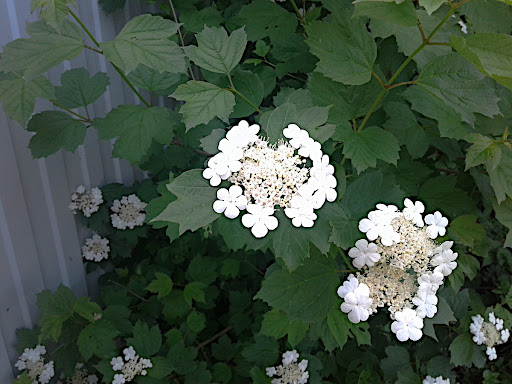Many of you are familiar with viburnum thanks to the wide distribution of Viburnum Common (Viburnum opulus). In the wild, it can be found in the forest at the edge or clearing. Viburnum is also grown in front gardens, near summer cottages, and even in urban plantings.
However, there are other types of Viburnum. These are viburnum burejaeticum, viburnum furcatum, viburnum dentatum, viburnum lantana), viburnum wrightii, viburnum sargentii.
One Viburnum Common
grows in my garden and is an unpretentious shrub that responds with
gratitude to the simplest care, giving in return bright flowering, lush
autumn foliage and an abundance of beautiful and healthy fruits.
My viburnum, like others, is very decorative. It blooms with its white, pinkish inflorescences. Flowering is long-lasting, sometimes extending for two to three weeks.
Viburnum has large, up to 12–15 cm in diameter, umbrella-shaped inflorescences, consisting of two types of flowers.
I just recently learned that in the center of the “umbrella” there are small tubular fruiting flowers, from which berries are subsequently formed. And along the edge there are larger and brighter sterile ones, the main task of which is to attract pollinating insects.
All viburnums are good honey plants. In autumn, they are in the brightest colors from yellow to carmine red. One poet compared the viburnum bush to a burning campfire.
I know that the fruits of viburnum are edible. Their juicy red berries lose their tart bitterness after frosty days. Then I collect them, sometimes make jelly, jam, puree, and also dry the berries.
Do you have viburnum in your garden? What variety is it? Do you use its berries?
My video about a park in Stockholm:






I have no viburnum in my garden, and I regret it. They are very beautiful when they bloom. The jam looks very tasty Nadezda!
ReplyDeleteMarit, The jam has a unique taste - sweet and sour and slightly tart, with a hint of bitterness. If you add more sugar, the taste is excellent.
DeleteI don't have any Viburnums and it's a pity because I think I would especially appreciate their berries and autumn colours of the leaves. Thank you for the interesting post and the lovely video!
ReplyDeleteHave a pleasant weekend!
You're right, Sara, in the fall the viburnum bush looks bright, the berries attract the eye, birds love them.
DeleteI had no idea that viburnum berries were used to make jam and jelly. Now I wish I could taste it! I will have to check at my local specialty food store to see if they have it. You have a prolific crop of berries, Nadezda, so perhaps you will me making lots this year. All the best - David
ReplyDeleteDavid, I will be picking black currants, gooseberries and raspberries at the end of July. And viburnum berries should be picked after the first frost (if the birds don’t eat them first!)
DeleteI love Viburnum and have it in my garden. It is very interesting about the fruits being made into jam. To answer your question about Prickly Pear, I have never eaten the fruit but hear that it is wonderful when prepared into a jam or jelly. I first learned about this plant and its uses while in college during a natural history course.
ReplyDeleteLee, thanks for your response about the Prickly Pear. If possible, I will buy prickly pear jam.
DeleteSe ve precioso y seguro que su mermelada está riquísima. Tengo uno en mí jardín, pero es Viburnum tinus y sus frutos no son comestibles, aunque son medicinales. Un abrazo.
ReplyDeleteSí, la mermelada está riquísima, Teresa. No sabía que viburnum tinus es medicinal.
DeleteWe don't have a viburnum but they are lovely
ReplyDeleteYou're right, Sue.
DeleteThank you. I had a good chance to know Viburnum.
ReplyDeleteYou're welcome, RTC. All the best.
DeleteFantastic photos ❤️ and a beautiful video.
ReplyDeleteI'm going on vacation until August and it will be difficult to visit friends, when I return home I'll return all your visits 😊
Greetings and all the best for you
Maria, I wish you a wonderful time on vacation! Wait for your new post.
DeleteThank you for your blog. It's great fun to look at your photos. Aren't those plants beautiful? In our garden, we have snowballs: Viburnum carlesi, and in autumn and winter, they're as bare as can be. You really think they're dead. For two years, they didn't bloom at all, but because we've had so much rain now, they're standing so beautifully in our garden. I'll take a photo of them soon.
ReplyDeleteI'm glad your Viburnum carlesi are in bloom, Aritha. I like to see them is the neighbor's garden as well.
DeletePrecioso video Nadezda me ha encantantado verlo.
ReplyDeleteNo tenemos viburnum y se ve rica la mermelada de sus bayas.
Buen fin de senana amiga.
Un abrazo.
Sí, la mermelada está rica, Laura, aunque un poco amarga. Me alegra que te haya gustado mi vídeo.
DeletePreciosas fotos de un hermoso arbusto. Desconocía que se podía hacer mermelada con sus bayas. Besos.
ReplyDelete